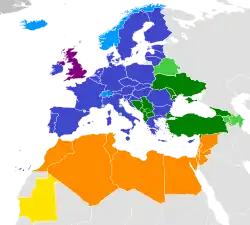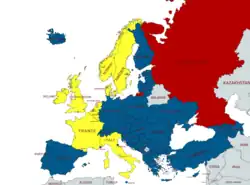Greater Europe
Greater Europe refers to the idea of an extended Europe. This generally implies a Europe which transcends traditional geographic boundaries to include trans-Eurasian countries,[1] or countries in close proximity to Continental Europe with strong political, economic, or cultural links to Europe.[2]

Definitions

The concept of Greater Europe may specifically deal with the current enlargement agenda or the potential future enlargement of the European Union.
It may also reference a more "re-unified" Europe following the fall of the Iron Curtain,[3] the intensification of European integration, the potential establishment of a Federal Europe, or to the concept of the Eurosphere and of Europe's increasing global influence.[4][5][6]
Other definitions of Greater Europe may include all European states and CIS countries; or all European states and the Post-Soviet states of the Eurasian Economic Union; theoretically stretching from Lisbon to Vladivostok.

Support

Several organizations exist promoting discussion and debate surrounding Greater Europe, among them the Institute for a Greater Europe and the Youth Association for a Greater Europe.[7] There are also several organizations which promote increased dialogue and greater economic and political integration among states within Greater Europe, including:
- Assembly of European Regions
- Commonwealth of Independent States
- Council of Europe
- Eastern Partnership
- Euro-Mediterranean Parliamentary Assembly
- Euronest Parliamentary Assembly
- European Bank for Reconstruction and Development
- European Higher Education Area
- European Olympic Committees
- Mediterranean Union
- Organization for Security and Co-operation in Europe
- Organization of the Black Sea Economic Cooperation
- TRACECA
Economic integration in greater Europe
Lisbon Vladivostok initiative
The vision of a common economic space from Lisbon to Vladivostok has been debated since the 1950s. The Lisbon Vladivostok Initiative believes that this vision can be turned into reality, and sees a multi-level partnership between the European Union (EU) and the Eurasian Economic Union (EAEU) as the core aspect of a common economic space. Cooperation between the EU and EAEU could bring enormous benefits for trade and business in Europe and Eurasia. The Initiative was founded in 2015 and is driven by businesses, business associations, and think tanks from member countries of the EU and EAEU. Among the founding members are the German-Russian Forum, the German Chamber of Commerce, and the German Eastern Business Association, as well as international corporations such as Siemens, Bosch, Severstal and others. Today, the Initiative counts on more than 100 members from 12 countries from the EU and EAEU. It sees itself as an open circle involving all countries from Lisbon to Vladivostok.
Goals of the Lisbon Vladivostok initiative
The markets of the EU and the EAEU cover more than 630 million inhabitants. Despite different levels of development of the two unions, by creating lasting networks between officials, maintaining continual dialogue, and through the establishment of a common economic area in the countries of the EU and the EAEU, it may be possible to combat European and Eurasian issues of the future more effectively.
References
- Russia and the West: the 21st century security environment. M.E. Sharpe. 1999. p. 158. ISBN 978-0-7656-0432-3.
- Coca-Cola Forms 2 New Overseas Units; The New York Times; 21 January 2000; retrieved 7 August 2008
- Towards greater Europe?: a Continent without an iron curtain. Blackwell Publishers. 1992. ISBN 978-0-631-18551-2.
- Russian media reports on Yeltsin's pledge to cut troops; BBC News; 3 December 1997; retrieved 7 August 2008
- EU and Russia Agree to Strengthen Ties; DW-world; 10 May 2005; retrieved 7 August 2008
- Commission creates 'Wider Europe' task force; EurActiv; 10 July 2003; retrieved 7 August 2008
- "Institute for a Greater Europe". IGE. Retrieved 2020-04-08.
External links
- "Report on the Implementation of the European Security Strategy - Providing Security in a Changing World - Brussels, 11 December 2008 S407/08" (PDF).
- Greater Europe: Putin's vision of Europe (Dis)integration by Marek Menkiszak